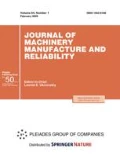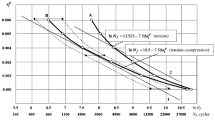Abstract
A methodology for simulating mathematically the limit states of machines and structures subjected to quasi-static operational and shock impacts is generated by considering great (final) deformations and degradation of the properties of materials. The known experimental results and the modern mesomechanics conceptions on the structure, damage, and nonlinear processes of viscous-plastic faults of polycrystalline metals under high temperatures and loading rates are the basis of the mathematical models used. The results of simulation of a preliminarily loaded stripe with a cut in the area where two different materials are joined and which is subjected to shock impact are presented. Such bimetallic joints are typical for structures widely used in technical engineering, and they are of particular attention under operation. How the parameters of quasi-static loading and degradation of material properties influence the wave processes of deformation and the limit states important for lifetime estimation are shown.






Similar content being viewed by others
REFERENCES
Lifetime-Oriented Structural Design Concepts, Stangenberg, F., Breitenbücher, R., and Bruhns, O.T., Eds., Berlin: Springer, 2009.
Ashby, M.F. and Jones, D.R.H., Engineering Materials. 2. An Introduction to Microstructures, Processing and Design, Oxford: Elsevier, 2006.
Petushkov, V., Numerical simulation of high-velocity dynamics of the nonlinear deformation and failure of damaged medium, Math. Models Comput. Simul., 2010, vol. 2, no. 1, p. 76.
Petushkov, V.A. and Nadareishvili, A.I., The 3-D bodies nonlinear deformation and damage processes by highvelocity impact collisions, Mat. Model., 2004, vol. 16, no. 11, p. 33.
Petushkov, V.A. and Frolov, K.V., Dynamics of hydroelastic systems under pulsed excitation, in Dinamika konstruktsii gidroaerouprugikh sistem (The Dynamics of the Design of Hydroaeroelastic Systems), Moscow: Nauka, 2002, p. 162.
Romanov, A.N., Struktura i prochnost’ konstruktsionnykh materialov (The Structure and Strength of Structural Materials), Moscow: MTsNTI, 1988, no. 4.
Rabotnov, Yu.N., Mechanism of prolonged destruction, in Voprosy prochnosti materialov i konstruktsii (Strength Issues of Materials and Structures), Moscow: Akad. Nauk SSSR, 1959, p. 5.
Curran, D.R., Seaman, L., and Shockey, D.A., Dynamic failure of solids, Phys. Rep., 1987, vol. 147, p. 253.
Alves, M., Measurement of ductile material damage, Mech. Struct. Mach., 2001, vol. 29, p. 451.
Lebedev, A.A. and Chausov, N.G., Novye metody otsenki degradatsii mekhanicheskikh svoistv metalla konstruktsii v protsesse narabotki (New Methods for Assessing the Degradation of the Mechanical Properties of Metal Structures during Running Hours), Kiev: Inst. Probl. Prochnosti im. G.S. Pisarenko NANU, 2004.
Petushkov, V.A., Local flows of a deformable damageable medium under impact interaction with a cavitating fluid, Fluid Dyn., 2007, vol. 42, no. 3, p. 442.
Aifantis, E., The physics of plastic deformation, Int. J. Plast., 1987, vol. 3, p. 211.
Brunig, A., Chyra, O., Albrecht, D., et al., A ductile damage criterion at various stress triaxialities, Int. J. Plast., 2008, vol. 24, p. 1731.
Petushkov, V.A., Viscoplastic flows and strain localization in a damageable medium under impact loading, Zh. SFU,Ser.: Mat. Fiz., 2009, vol. 2, no. 3, p. 336.
Nadareishvili, A.I. and Petushkov, V.A., A generalized model of supercritical behavior of damaged bodies under shock loads, Probl. Mashinostr. Avtomat., 2008, no. 4, p. 94.
Dornowski, W. and Perzyna, P., Numerical investigation of macro crack propagation along a bimaterial interface in adiabatic dynamic processes as a problem of micromechanics, Eng.Trans., 2006, p. 289.
Petushkov, V.A., Transient dynamics of 3D inelastic heterogeneous media analysis by the boundary integral equation and the discrete domains methods, Vestn. Sam. Tekh. Univ., Ser. Fiz.-Mat. Nauki, 2017, vol. 21, no. 1, p. 137.
Celentano, D.J. and Chaboche, J.L., Experimental and numerical characterization of damage evolution in steels, Int. J. Plast., 2007, vol. 23, p. 1739.
Author information
Authors and Affiliations
Corresponding author
About this article
Cite this article
Petushkov, V.A. To Forecasting Residual Lifetime of Damaged Constructions under Shock Impacts in Operation. J. Mach. Manuf. Reliab. 49, 159–169 (2020). https://doi.org/10.3103/S1052618820020119
Received:
Revised:
Accepted:
Published:
Issue Date:
DOI: https://doi.org/10.3103/S1052618820020119




